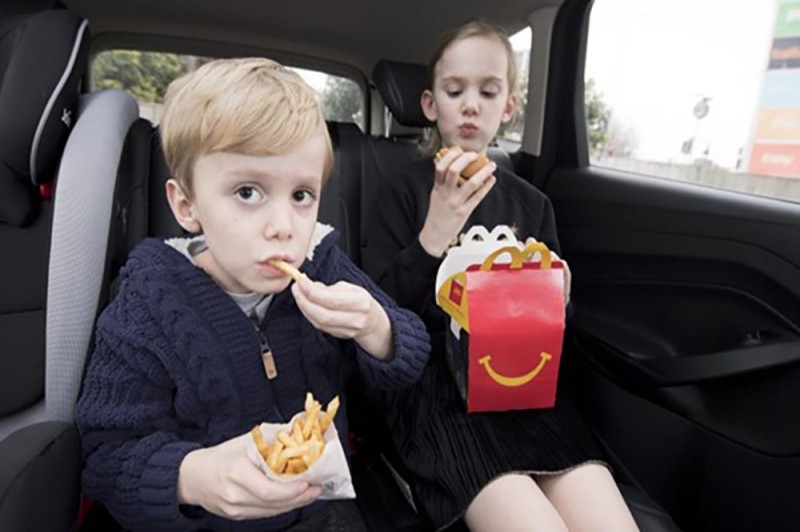
麦当劳(McDonald’s)以“金色拱门”闻名,Cava以醒目的四个字母印在外卖袋上为标志。但如今,这两家餐饮连锁企业都用同一个字母来概括眼下的经营现状:K。
两家快餐公司的首席执行官成为餐饮业最新一批发出“K型经济”警告的高管。所谓“K型经济”,是指高收入群体消费依旧旺盛,而低收入群体则被迫勒紧裤腰带、削减支出。
麦当劳首席执行官克里斯·坎普钦斯基在周三的财报电话会议上表示:“消费者群体的两极分化仍在持续——快餐门店的低收入消费者客流量在第三季度下降了近两位数,这一趋势已持续近两年。”他重申了今年9月曾提到的“二元经济”风险。“相比之下,快餐门店的高收入消费者客流量依然强劲,本季度增长接近两位数。”
虽然麦当劳本季度盈利不及预期,但整体销售额上升,其中美国市场当季同店销售额增长2.5%,这一业绩部分归功于2.99美元鸡肉卷的持续热销,该产品专为节省型顾客设计。
Cava是一个长期深受白领和郊区顾客青睐的休闲快餐连锁品牌。但如今,它同样面临难以吸引低收入消费者的难题。这家地中海风格的餐饮品牌下调了全年销售增长预期,并报告称其客流量增长停滞,同店销售额仅增长1.9%,低于市场预期的2.7%。其联合创始人兼首席执行官布雷特·舒尔曼表示,由于年轻群体面临财务压力,要吸引他们消费尤为困难。
舒尔曼周二在投资者电话会议上表示:“我们不想夸大消费者面临的困难,但数据已经一目了然。无论是学生贷款偿还、消费信心,还是来自医疗和住房成本等各方面的通胀压力,再加上Z世代失业率达到全国平均水平的两倍,这些都是切实存在的问题。”
他补充道:“从数据来看,25到35岁的年轻群体今年的消费势头明显减弱,到店消费意愿和频次较去年都有所下降。”
舒尔曼在接受彭博社采访时还指出,同店销售额增长主要来自部分消费者加点配菜或选择价格更高的蛋白类食材(如牛排),这表明正是高收入消费者在支撑Cava的业绩,而其他群体正在缩减开支。
行业趋势
麦当劳与Cava关于消费者困境的观察并非个例。上周,Chipotle首席执行官斯科特·博特赖特和Shake Shack首席执行官罗布·林奇也指出,年轻顾客群体正因经济压力而减少外出就餐。
博特赖特在上月的财报电话会议上对投资者表示:“年轻群体正面临多重压力,包括失业率上升、学生贷款偿还压力增加以及实际工资增长放缓等。他们并不是被竞争对手抢走,而是流向了食品杂货店和居家饮食。”
根据FICO的最新报告,年轻群体——尤其是许多背负学生贷款的年轻人——收缩消费的趋势尤为明显,自2020年以来,该群体的信贷额度下降幅度在各年龄段中最为严重。圣路易斯联邦储备银行(Federal Reserve Bank of St. Louis)的数据显示,16至24岁年轻人的失业率几乎是千禧一代和X世代的三倍,他们正同时面临AI冲击与就业市场停滞的双重挑战。
因此,年轻人不得不放弃外出就餐。根据Redfin今年8月对4,000名美国房主与租客的调查,约40%的Z世代和千禧一代租客表示,为了支付账单,减少了外出就餐次数;还有五分之一的年轻人坦言,为了省钱,他们甚至什么都不吃。
虽然这些餐饮连锁企业都观察到消费者群体的“两极分化”,但它们采取的应对策略却大相径庭。快餐连锁品牌麦当劳坚持主打“实惠路线”,继续销售鸡肉卷,并在9月恢复了疫情以来的首个“超值套餐”促销活动。
而Cava则强调自己并非快餐店。舒尔曼表示,即便顾客需要多付几美元,公司仍将继续坚守“健康优选”的品牌定位,突出新鲜食材与更高端蛋白食材的使用。
舒尔曼在投资者会议上表示:“我们不会通过大幅打折来应对周期性挑战。这正是我们强调要加倍提升运营质量和顾客体验的原因。我们希望尽一切努力,让消费者在面对开销压力的时期,依然能在Cava获得优质的体验。”(*)
译者:刘进龙
审校:汪皓
麦当劳(McDonald’s)以“金色拱门”闻名,Cava以醒目的四个字母印在外卖袋上为标志。但如今,这两家餐饮连锁企业都用同一个字母来概括眼下的经营现状:K。
两家快餐公司的首席执行官成为餐饮业最新一批发出“K型经济”警告的高管。所谓“K型经济”,是指高收入群体消费依旧旺盛,而低收入群体则被迫勒紧裤腰带、削减支出。
麦当劳首席执行官克里斯·坎普钦斯基在周三的财报电话会议上表示:“消费者群体的两极分化仍在持续——快餐门店的低收入消费者客流量在第三季度下降了近两位数,这一趋势已持续近两年。”他重申了今年9月曾提到的“二元经济”风险。“相比之下,快餐门店的高收入消费者客流量依然强劲,本季度增长接近两位数。”
虽然麦当劳本季度盈利不及预期,但整体销售额上升,其中美国市场当季同店销售额增长2.5%,这一业绩部分归功于2.99美元鸡肉卷的持续热销,该产品专为节省型顾客设计。
Cava是一个长期深受白领和郊区顾客青睐的休闲快餐连锁品牌。但如今,它同样面临难以吸引低收入消费者的难题。这家地中海风格的餐饮品牌下调了全年销售增长预期,并报告称其客流量增长停滞,同店销售额仅增长1.9%,低于市场预期的2.7%。其联合创始人兼首席执行官布雷特·舒尔曼表示,由于年轻群体面临财务压力,要吸引他们消费尤为困难。
舒尔曼周二在投资者电话会议上表示:“我们不想夸大消费者面临的困难,但数据已经一目了然。无论是学生贷款偿还、消费信心,还是来自医疗和住房成本等各方面的通胀压力,再加上Z世代失业率达到全国平均水平的两倍,这些都是切实存在的问题。”
他补充道:“从数据来看,25到35岁的年轻群体今年的消费势头明显减弱,到店消费意愿和频次较去年都有所下降。”
舒尔曼在接受彭博社采访时还指出,同店销售额增长主要来自部分消费者加点配菜或选择价格更高的蛋白类食材(如牛排),这表明正是高收入消费者在支撑Cava的业绩,而其他群体正在缩减开支。
行业趋势
麦当劳与Cava关于消费者困境的观察并非个例。上周,Chipotle首席执行官斯科特·博特赖特和Shake Shack首席执行官罗布·林奇也指出,年轻顾客群体正因经济压力而减少外出就餐。
博特赖特在上月的财报电话会议上对投资者表示:“年轻群体正面临多重压力,包括失业率上升、学生贷款偿还压力增加以及实际工资增长放缓等。他们并不是被竞争对手抢走,而是流向了食品杂货店和居家饮食。”
根据FICO的最新报告,年轻群体——尤其是许多背负学生贷款的年轻人——收缩消费的趋势尤为明显,自2020年以来,该群体的信贷额度下降幅度在各年龄段中最为严重。圣路易斯联邦储备银行(Federal Reserve Bank of St. Louis)的数据显示,16至24岁年轻人的失业率几乎是千禧一代和X世代的三倍,他们正同时面临AI冲击与就业市场停滞的双重挑战。
因此,年轻人不得不放弃外出就餐。根据Redfin今年8月对4,000名美国房主与租客的调查,约40%的Z世代和千禧一代租客表示,为了支付账单,减少了外出就餐次数;还有五分之一的年轻人坦言,为了省钱,他们甚至什么都不吃。
虽然这些餐饮连锁企业都观察到消费者群体的“两极分化”,但它们采取的应对策略却大相径庭。快餐连锁品牌麦当劳坚持主打“实惠路线”,继续销售鸡肉卷,并在9月恢复了疫情以来的首个“超值套餐”促销活动。
而Cava则强调自己并非快餐店。舒尔曼表示,即便顾客需要多付几美元,公司仍将继续坚守“健康优选”的品牌定位,突出新鲜食材与更高端蛋白食材的使用。
舒尔曼在投资者会议上表示:“我们不会通过大幅打折来应对周期性挑战。这正是我们强调要加倍提升运营质量和顾客体验的原因。我们希望尽一切努力,让消费者在面对开销压力的时期,依然能在Cava获得优质的体验。”(*)
译者:刘进龙
审校:汪皓
McDonald’s may be known for its golden arches, and Cava for its four-letter name boldly stamped on each takeout bag, but both restaurant chains use the same letter to sum up business right now: a big K.
The respective fast-food CEOs are the latest in the restaurant business to sound the alarm of a K-shaped economy, where high-income earners are spending as if nothing is wrong, while lower-income Americans tighten their belts and pull back on spending.
“We continue to see a bifurcated consumer base with [quick-service restaurant] traffic from lower-income consumers declining nearly double digits in the third quarter, a trend that’s persisted for nearly two years,” McDonald’s CEO Chris Kempczinski said during the company’s earnings call on Wednesday, echoing a warning about a two-tiered economy he brought up in September. “In contrast, QSR traffic growth among higher-income consumers remains strong, increasing nearly double digits in the quarter.”
McDonald’s earnings missed estimates, but it saw rising sales, including a 2.5% increase in U.S. comparable sales for the quarter, in part because of the sustained popularity of the $2.99 chicken Snack Wrap meant to appeal to budget-minded customers.
Cava, a fast-casual chain that has historically attracted white-collar workers and suburbanites, is having similar issues attracting lower-income diners. The Mediterranean-inspired restaurant cut back its full-year sales growth guidance, reporting flat foot traffic and a 1.9% increase in comparable sales—short of expectations for 2.7%. Cofounder and CEO Brett Schulman said younger customers are a particular challenge to reach because of the financial difficulties they are facing.
“We don’t want to overstate the challenges of the consumer, but you can look at the data,” Schulman told investors on Tuesday. “They’re clearly out there, whether it’s student loan repayment, consumer sentiment, just the inflationary pressures all around them, whether it’s health care cost, housing costs—Gen Z unemployment [is] twice the national average.
“When we look at the data, it’s more that the younger cohort, that 25-to-35 … they don’t have the steam that they had last year in the way that they were visiting or their frequency of visiting,” he added.
Schulman told Bloomberg the increase in comparable sales was the result of some consumers adding sides or ordering more premium proteins like steak, suggesting wealthier consumers are propping up Cava as others pull back.
Industry trends
McDonald’s and Cava’s observations about consumer struggles aren’t happening in isolation. Last week, Chipotle CEO Scott Boatwright and Shake Shack CEO Rob Lynch noted that young customers in particular are cutting back owing to financial pressures.
“This group is facing several headwinds, including unemployment, increased student loan repayment, and slower real wage growth,” Boatwright told investors on the company’s earnings call last month. “We’re not losing them to the competition. We’re losing them to grocery and food at home.”
Pullback behaviors are pronounced in young people—including many saddled with student loans—who experienced the steepest annual drop in credit of any generation since 2020, according to a recent FICO report. The unemployment rate for 16- to 24-year-olds—confronted with threats of AI and a stagnating job market—is nearly three times that of millennials and Gen Xers, according to data from the Federal Reserve Bank of St. Louis.
Young people have, as a result, sacrificed dining out. About 40% of Gen Z and millennial renters have reported eating out less to afford to pay the bills, according to an August Redfin survey of 4,000 U.S. homeowners and renters. One in five young people reported skipping meals entirely to save money.
While these restaurant chains have made similar observations about a two-tiered consumer base, their strategies on how to address consumer headwinds diverge significantly. McDonald’s, as a fast-food chain, has continued to lean into affordability with its Snack Wraps and the return of its Extra Value Meals in September, the first of such promotions since the pandemic.
Cava, however, has reiterated it is not a fast-food restaurant. Schulman said the company will continue to rely on its better-for-you branding of fresh ingredients and more premium proteins that some diners may have to pay a couple extra dollars for.
“We’re not going to get into that heavy discounting to combat any cyclical headwinds. That’s why we talked about doubling down on exceptional operations and great guest experiences,” Schulman told investors. “We want to make sure we’re doing everything we [can] in that spirit to deliver for our guests in this time when they’re feeling pressures all around you.”

